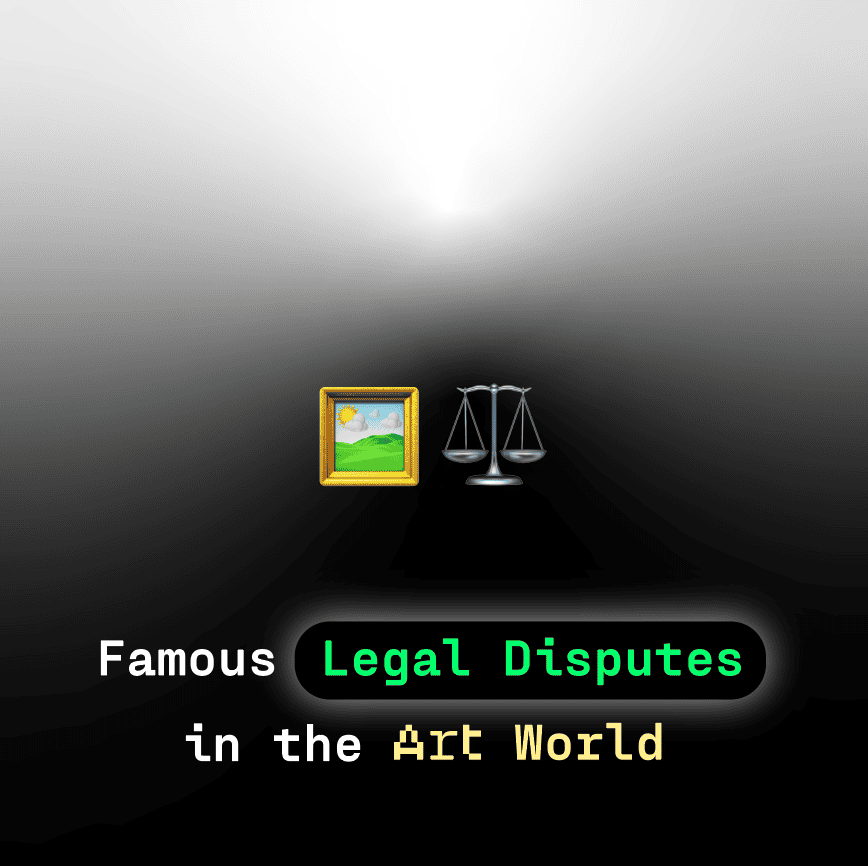Famous Legal Disputes in the Art World
By Terrain.art | Apr 15 2022 · 5 min read
From notions of ownership to moral rights of the artists, legal disputes over artworks shed light over a gamut of tricky issues
Disputes over copyright and ownership of artworks have long been a feature of the art world. But such disputes do more than settle scores. They call into question our notions of intellectual property rights, ownership of creative works, and fair use. Additionally, they catalyse social and cultural discourses on art; sometimes provoking governments to streamline the laws related to copyright and art ownership. Here are some of the most famous legal art disputes:
Rogers versus Koons (1991)
This dispute called into question the thin line that demarcates ‘being inspired creatively’ from ‘copying’. Art Rogers, a professional photographer, took a picture of an elderly couple, holding a bunch of puppies. The photograph, meant to be used on greeting cards and other similar merchandise, caught the attention of famous artist Jeff Koons, who made a sculpture inspired by it. The artwork, meant to reflect on the “banality of everyday life”, led to a huge controversy with Rogers slapping a lawsuit against Koons. Although Koons pleaded for “fair use by parody”, the court ruled in favour of Rogers, arguing that Koon’s work bore a similarity so close that any lay person would be able to recognize the resemblance. Koons was forced to pay a handsome amount to Rogers out of the USD 367,000 that came from the sale of the sculpture.
Sotheby’s versus Government of Greece (2018)
What nuances entail the provenance of any artwork? In 2018, an international auction house Sotheby’s was preparing to auction a small Greek horse from the 8th century BCE. It received a letter from The Ministry of Culture and Sports in Greece, alleging that the statue might have been illegally exported from the country and that the auction house should remove it from the list of items for sale. Although Sotheby’s reluctantly removed the sculpture, it sued the government of Greece, pleading that its interference has affected the commercial activities of the auction house. Later, the Greek attorneys filed a motion, calling for the lawsuit to be dismissed since the US district court, where the lawsuit was filed, had no jurisdiction over a foreign country that enjoyed sovereign immunity. This case is a reminder as to why we need blockchain-backed NFT transactions while buying and selling artworks. You can learn more about provenance here.
The Associated Press versus Fairey (2009)
One of the important instances when the notion of fair use was oppugned was the case of Shepard Fairey versus the Associated Press (AP). Famous street artist Shepard Fairey created the well-known Hope poster, depicting Obama in saturated colours of the American flag. Widely used in the presidential campaign of 2008, the poster was later revealed to be a copy of a photograph taken by photojournalist Mannie Garcia. AP filed a lawsuit, demanding compensation. Later, Garcia reached an out-of-court settlement with AP for an undisclosed sum, which included splitting profits between the two parties from the proceeds of the sale.
Fletcher versus Doig (2016)
Reputation matters, especially in the art market. The value of an artwork increases manifold when it bears the name of an illustrious creator. But what if the alleged creator of an artwork denies the authorship to himself? Something similar happened in 2016 when internationally acclaimed artist Peter Doig was sued for damages upon refuting the ownership of a painting that negatively impacted its market price. The plaintiff, in this case, a person named Fletcher, alleged that he bought the painting from one Pete Doige, who was the very same person as the defendant, Peter Doig. The artist, on his part, claimed that he never created the artwork, nor did he ever meet Fletcher. The case, which was widely reported in the media, was dismissed by a US trial court.
Jatin Das versus Union of India (2012)
Does an artist have a right over how his work is displayed, especially if it is a public art installation? Jatin Das, one of India’s most renowned artists, was shocked to see that his iconic Flight of Steel installation was removed from a popular cross-section in Bhilai, dismembered and disfigured beyond recognition by the Steel Authority of India, which was also the commissioning agency. The defendants argued that the installation was removed in favour of the construction of a flyover. Although the court constituted a committee to investigate the matter and suggested ways to restore the installation, Das said that the installation was site-specific, and nothing could be done to restore it. The matter is still pending in the Delhi High Court.
While notions of authorship, the artist’s moral rights, fair use, product identity, are some of the subjects that require an in-depth discussion, these cases highlight the pressing need to address these challenges on priority basis. Thankfully, with Terrain.art you can be rest assured about provenance and the authenticity of the artwork you buy, for it incorporates the blockchain technology to track uniquely identified artworks.

